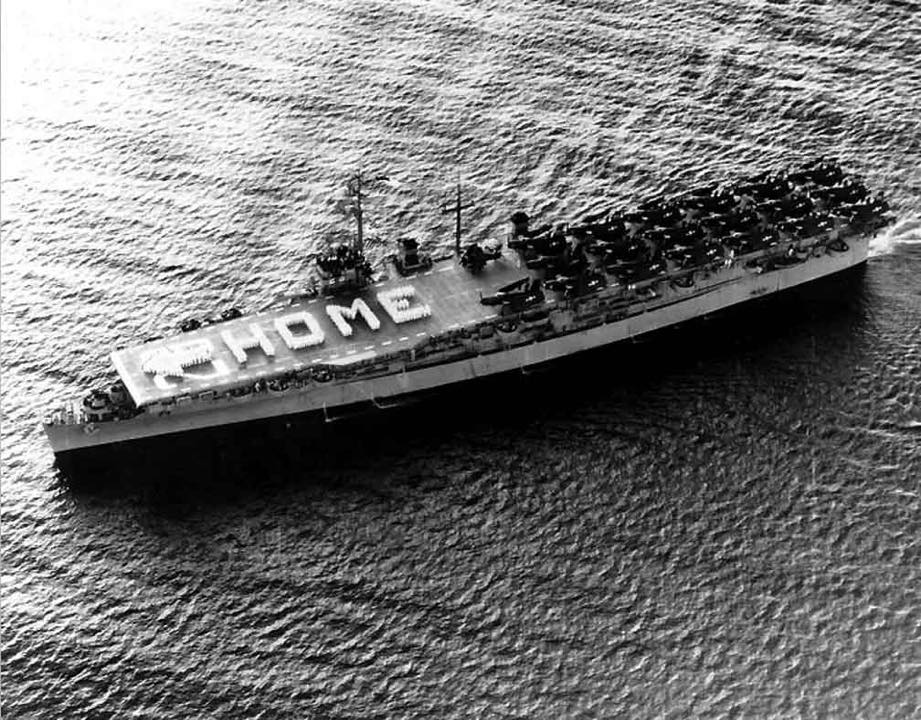CVL-29 USS Bataan

USS Bataan CVL-29
(Displacement: 11,000 tons; length: 622½ feet; beam: 71½ feet; extreme width at flight deck: 109 feet 2 inches; draft: 26 feet; speed: 32 knots; complement: 1,569 crew; armament: 26 40mm guns; class: Independence)
The cruiser Buffalo (CL-99) was reclassified as CV-29 and renamed Bataan on 2 June 1942. The ship was reclassified as CVL-29 on 15 July 1943 and launched on 1 August 1943 by New York Shipbuilding Corp., Camden, N.J.; sponsored by Mrs. George D. Murray, wife of Rear Adm. Murray. Bataan was commissioned on 17 November 1943, with Captain V. H. Schaeffer in command, and reported to the Pacific Fleet.
In her initial engagement with the Japanese, Bataan's planes supported the attack on Hollandia, New Guinea, between 21 and 24 April 1944. Following this action were strikes against Truk, Satawan, and Ponape (29 April - 1 May 1944); Saipan, Marianas (11 June - 10 August); 1st Bonins raid (15-16 June); Battle of the Philippine Sea (19-20 June), and the 2nd Bonins raid (24 June).
Bataan then returned to the United States for repairs. With repairs completed, she joined TF 58 and participated in the fleet raids in support of the Okinawa operation (17 March - 30 May 1945), during which her aircraft assisted in the sinking of the Japanese submarine I-56 on 18 April 1945, in 26°42' N., 130°38' E. Retiring to the Philippines, Bataan joined the 3rd Fleet for operations against the Japanese home islands (10 July - 15 August).
Bataan returned to the United States, arriving in New York on 17 October 1945, and was assigned to "Magic Carpet" duty. On 10 January 1946, she arrived in Philadelphia to prepare for inactivation. Bataan went out of commission in reserve on 11 February 1947. Bataan was recommissioned on 13 May 1950 at Philadelphia. In July 1950, she stood out for San Diego, upon arrival loaded Air Force cargo and personnel, and departed on 16 November for Tokyo Bay. She arrived in Korean waters on 15 December and until June 1951, her aircraft flew strikes in support of the ground forces.
Bataan departed for the west coast on 2 June 1951 and, after a brief stop in San Diego, steamed to Bremerton, Wash., on 9 July for overhaul. She returned to San Diego on 20 November and, on 27 January 1952, departed for Yokosuka, Japan, and then to Buckner Bay, Okinawa. She conducted air exercises and other training maneuvers off Okinawa until 29 April, when she sailed for Korean waters. Bataan continued operating between Japan and Korea throughout the summer of 1952, carrying personnel and supplies to the fighting area and launching strikes against the enemy. She left the fighting zone on 11 August for San Diego. On 27 October 1952, the carrier once again stood out for the Far East and operated off Korea until 10 May 1953 when she departed for San Diego.
She remained in the San Diego area undergoing overhaul and training until 31 July. Then she sailed via Pearl Harbor to Kobe and Yokosuka, Japan, and then back to the United States where she reported for inactivation on 26 August 1953. She went out of commission in reserve on 9 April 1954 in San Francisco. She was stricken from the Navy List in September 1959 and sold for scrapping in May 1961. Bataan received six battle stars for her World War II service and seven for her Korean service.
